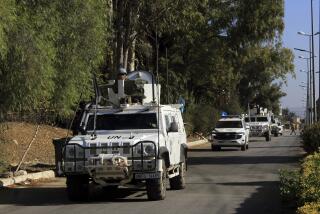NATO keeps bombing pro-Kadafi forces in Libya
- Share via
Reporting from Tripoli, Libya, and Washington — With Moammar Kadafi’s forces on the run, NATO air crews have continued to pound remaining loyalist troops outside Tripoli in enclaves such as Surt, the longtime dictator’s tribal stronghold 225 miles east of the capital.
To some, the continued strikes again raise the question of whether NATO is acting as a rebel “air force” or is keeping with its U.N. mandate to protect civilians.
NATO says it has not taken sides in the Libyan civil war, and has only supported the “Libyan people.” Yet rebel leaders acknowledge that their inexperienced and ill-equipped forces could not have routed Kadafi without the Western alliance’s control of the skies.
Critics say it is a convenient fiction to maintain that NATO has not sided with the rebels, considering that the airstrikes often have accompanied rebel offensives, or struck Kadafi forces poised to attack rebel positions.
At the heart of the matter is whether NATO’s actions are consistent with the United Nations mandate of protecting civilians facing danger from Libyan government forces.
Nora Bensahel, a senior fellow at the Center for a New American Security, said the strikes on Surt appear consistent with NATO’s own definition of what’s acceptable under the international mandate.
“But there’s a broader question about whether those attacks are consistent with the U.N. mandate,” she said. “And that debate remains ongoing.”
Indeed, U.N. member states — including Russia, China, Brazil, India and South Africa — have complained bitterly that the North Atlantic Treaty Organization has stretched the mandate. And some diplomats speculate that it may be more difficult now, because of this push-back, to persuade the U.N. Security Council to approve future action against other governments that react violently to citizens engaged in street protests, such as Syria.
Michael O’Hanlon, a military specialist at Brookings Institution, said that in his view, “The rules have already stretched pretty far, and this is not particularly egregious, as the cities with Kadafi loyalists can’t be safe until the war is over. And with the finish line in sight, it makes sense to go for it.”
Rebel forces have publicly urged that NATO continue its strikes as they plan an all-out assault on Surt if the city does not surrender by Saturday. Many believe Kadafi is hiding there.
On Monday and Tuesday, NATO said, bombing runs on Surt struck 34 armed vehicles, four command-and-control sites, three tanks, five radar sites and two military facilities. Other strikes have hit military targets, including three Scud surface-to-surface missile launchers in or near Bani Walid, another remaining loyalist enclave southeast of Tripoli, where some also think Kadafi may be holed up.
NATO says it is not softening up Surt for a rebel offensive that will include tanks and other armored vehicles arrayed against a city of more than 100,000 people. Rather, officials said, the alliance’s continued strikes on Kadafi’s forces, even in their diminished state, fit squarely within the mandate to protect civilians.
“Certainly, he [Kadafi] continues to be a threat,” Col. Roland Lavoie, a NATO spokesman, said Wednesday in a telephone interview from Naples, Italy, headquarters for the NATO operation.
“We have a clear sense that what is left of the regime still displays not only an intent but to some limited but real capacity … a threat to the people of Libya,” said Lavoie, a Canadian. “That threat is not in a specific village or place in time but it is in general.… As far as we’re concerned, the threat still exists, and the last thing we want to do is let Kadafi consolidate his assets, and continue to do what he has been doing since the beginning of this conflict.”
Asked whether he had any evidence that pro-Kadafi units posed specific threats to people in areas still under Kadafi’s nominal control, Lavoie said, “I have nothing specific I can point to.”
Pro-Kadafi media allege that the recent bombings killed 36 people in Bani Walid.
NATO has repeatedly dismissed allegations that it has targeted Kadafi, despite aerial attacks on his Tripoli compound and family residences. Since March 31, when it took over the task from a Western-led alliance, NATO has flown almost 21,000 sorties, including almost 8,000 strike sorties.
“I go back to our mandate, the side we take, is not anti- or pro-Kadafi; we take the side of the Libyan people,” Lavoie said. “Our mission is to protect them.”
Kadafi’s forces, he said, have not pulled back in confusion, but rather in an organized fashion that leaves them capable of continued attacks.
“They are not in total disarray, going in all directions. When they have trouble in one area, they orderly fall back to the second-best position.… They still behave in a military fashion, displaying a clear posture.”
In Tripoli, however, many of Kadafi’s soldiers shed their uniforms and Kalashnikov assault rifles as the rebels advanced.
Asked how long NATO will continue Libyan operations, officials say the timing is not directly linked to the future of Kadafi. NATO says its task will be complete only when civilians are no longer threatened.
“The mission will continue in full compliance with the United Nations mandate for as long as it’s needed, but not a day longer,” Oana Lungescu, a NATO spokeswoman, told reporters this week.
“It looks as if we’re nearly there, but we’re not there yet.”
McDonnell reported from Tripoli and Richter from Washington.
More to Read
Sign up for Essential California
The most important California stories and recommendations in your inbox every morning.
You may occasionally receive promotional content from the Los Angeles Times.











